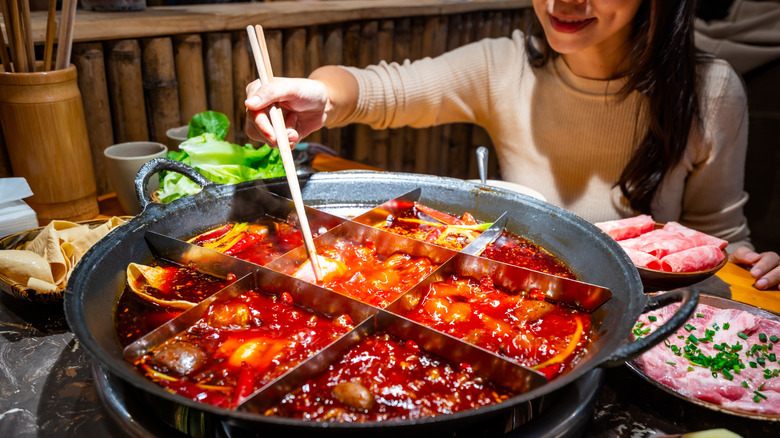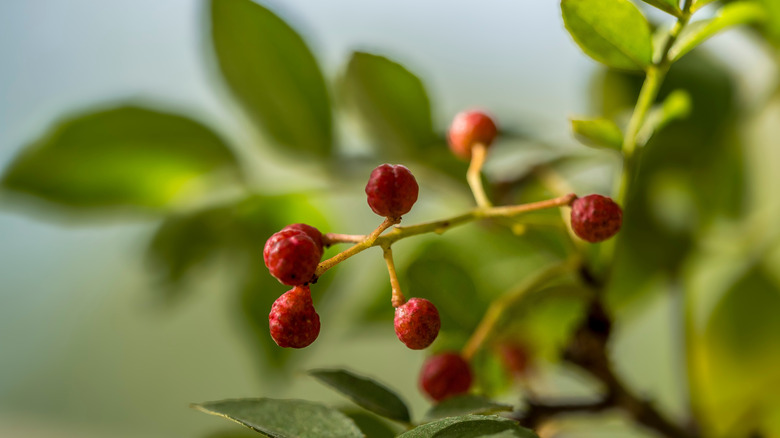When Searching For Good Sichuan, Look For One Signature Flavor
Sichuan cuisine is world-famous — but stateside, good Sichuan food isn't always easy to find. Many of the region's most famous dishes use Sichuan peppercorns to create the iconic málà (or "spicy and numbing") flavor. Málà is key if you're on the hunt for good Sichuan food, but actual Sichuan peppercorns are scarce in the US. Why are peppercorns so important, and how do they play into the landscape of Sichuan cuisine?
The Takeout asked Chef Shirley Chung to clarify. The Beijing-born chef and restaurateur has spent most of her impressive career educating American audiences on Chinese cuisine as a two-time Top Chef finalist, through social media, and also through her cookbook, "Chinese Heritage Cooking From My American Kitchen."
"Sichuan cuisine uses the numbing element of Sichuan peppercorn to balance the heat from the chili peppers," Chung explains. "The spicier the dish, more Sichuan peppercorns are used to cool down the pain from the heat." In short, Sichuan peppercorns aren't just for flavor; they work as an anesthetic so diners can enjoy the complex flavors of chilis without being overwhelmed.
Admittedly, the sensation itself is pretty intense. Even if you're sure you can handle the heat, you might be in for a shock — literally. Sichuan peppercorns aren't "spicy" in the same sense that members of the Capsicum (aka chili pepper) family are. The sensation is more electric: A 2013 study compared the buzzy feel you get from eating Sichuan peppercorns to 50 hertz, the frequency of an electrical grid.
What are Sichuan peppercorns?
Sichuan peppercorns aren't peppers at all. In the West, we think of peppers as either black peppercorns or chilis, another Sichuan staple. While chilis and black peppercorns are two separate species, Sichuan peppercorns aren't related to either. They're actually part of the citrus family, which explains their citrusy flavor. In China, the not-actually-peppercorns are called huājiāo, or "flower pepper." The name references the pretty, floral shape of opened peppercorns. Harvesting them is laborious: Farmers pick the tiny peppercorns one by one from thorny bushes.
Why go to all that trouble? Málà flavor aside, Sichuan peppercorns are used in traditional Chinese medicine — and studies have found that many of their old-school uses are backed up by modern science. The peppercorns have antioxidant, antibacterial, and antifungal properties and also help regulate the nervous and gastrointestinal systems. They may even help prevent tumors.
However, high-quality Sichuan peppers are hard to find in the United States. The U.S. banned the peppers in 1968 in an attempt to stop a disease from spreading which was affecting Chinese citrus trees, but the ban stuck around long after the blight was over. It wasn't lifted until 2005 — and even then, farmers had to heat-treat peppercorns and provide extra paperwork. Most farmers refused to sell to the U.S. It was too much hassle. The government eventually ditched those regulations, too, but the supply chain hasn't quite caught up. Even now, it's hard to find high-quality peppercorns in the United States.
What other flavors define Sichuan cuisine?
Sichuan peppercorn isn't the only flavor that helps define Sichuan cuisine. There are more — a lot more. "Sichuan cuisine is the cuisine with 100 flavors, the most complex of all Chinese regional cuisines," Chung says. "Balance of spicy heat, savory salt, heavy use of sugar, and acid carried with flavorful oils and dry aromatics is the key to a good Sichuan restaurant." That complexity is part of the reason why UNESCO honors Chengdu, the region's capital, as a UNESCO City of Gastronomy.
Chung had more to say about Sichuan cuisine's generous use of fats like chili oil and fatty meat. "You can not be afraid of fat," she said. Sichuan cuisine can be a great introduction to organ meat, too: classic dishes like fūqī fèi piàn go heavy on the offal. The dish, typically made from beef tripe or tongue, was originally a cheap snack for laborers. Now, it's one of the region's most iconic and beloved foods.
Still not sold on organ meat? Ease into Sichuan cuisine with favorites like dàndàn noodles and má pó dòufu (aka mapo tofu). Just remember: If your tongue isn't tingling, you're eating an Americanized approximation of actual Sichuan cuisine. Keep searching if you want the real deal.


